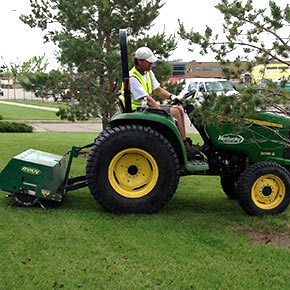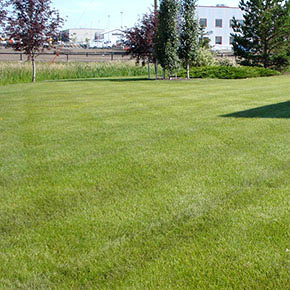When it comes to maintaining lush and healthy lawns there are two critical lawn care practices that are often overlooked: aerating and dethatching. Aerating, also commonly referred to as “core aerating” in the lawncare industry, is the process through which small holes are mechanically cored out of turfed areas. Dethatching is the practice of removing the previous year’s “thatch”; the dead and decaying blades of grass that accumulate between the soil’s surface and the grass itself. Aerating and dethatching are both key preventative maintenance practices that are used to combat soil compaction, increase water and nutrient retention, and promote healthy root growth.
Like all vegetation, turf grasses require air, water, sunlight, and nutrients to grow and thrive. When most people consider the needs of their lawns they immediately tend to gravitate towards fertilization, watering, and frequent mowing. While these common practices are beneficial to your lawn, one of the most overlooked factors in turf health is the composition of the soil in which it grows. Over time, the soil beneath the turf becomes compacted. Pedestrian traffic, pets, construction activities, even rain, can all be contributing factors. Soil that is too compacted will lead to the following problems:
- Poor water absorption and frequent water pooling
- Shallower turf root systems that are more susceptible to drought
- Inadequate air exchange and nutrient availability for roots resulting in stunted growth
- Thinner, shorter, and less vigorous growth that can lead to bare areas and patchy lawns
During aeration, hollow metal tines core out holes in the turf that are on average 0.5” wide and 3” deep. These holes allow air, water, and nutrients (i.e. fertilizer), to access the roots of turfgrasses where it is most needed. In addition, these holes are deep enough to penetrate the sod and subsoil, allowing newly sodded areas from previous years to fully take root and properly establish themselves. Within a matter of weeks, roots quickly fill the holes in the turf, and leftover cores disintegrate quickly. Aerating is recommended on an annual basis and, for the best results, lawns can be overseeded or fertilized shortly after.

Similar to aerating, dethatching improves the overall health of your turf by allowing air, sunlight, and nutrients to penetrate deeper into the turf itself. Over the years dead grass accumulates in lawns and slowly chokes out new growth. Thatch layers up to ½” are beneficial and act as a natural mulch and protective layer during drought. Lawns that have a spongy feel, or that give under the foot, often have thatch layers that are more than 1/2”. Thick layers of thatch and dead organic material should be removed annually, as its accumulation can result in the following:
- Poor air circulation and turf root development
- Turf that roots in thatch layers, creating poor drought resistance
- Increase risk of disease and pest infestations
- Increase risk of snow and slime mold growth
- Waterlogged turf that chokes new growth
- Soft turfed surfaces that are harder to mow
At Kentucky Blue Grass our complete summer maintenance package includes dethatching and aerating on an annual basis. Dethatching is done in the first month of the season, during our spring cleanups, while aerating is done in the early summer. Aerating and dethatching, when combined with liquid nitrogen fertilization and weekly lawn maintenance, is the key to providing our customers with quality lawns they can be proud of.


